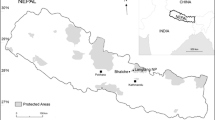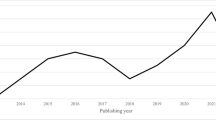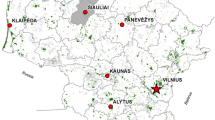Abstract
The Forest Stewardship Council (FSC) forest certification was introduced in Nepal with an assumption that it improves forests and ecosystem services while addressing the drivers of forest degradation. As of today, 89 community forests (CF) have been FSC certified, however empirical evidence on the contribution of forest certification on carbon stock and species richness is lacking. This research, thus tries to answer the question “do certified community forests (CCF) maintain higher carbon stock and species richness compared to non-certified community forests (NCF)?” The study collected field level data during February–May 2013 from 88 experimental plots. The study found higher carbon stock (p<0.05) and species richness, and lower ecological threat index (p<0.10) in the CCF, compared to NCF. The study showed that forest carbon stock is positively related to species richness, and negatively to ecological threat index. It suggests that sustainable forest management practices, that is generally adopted in the CCF, would minimize ecological threats, enriches species leading to enhanced carbon stock.



Similar content being viewed by others
References
Acharya B (2007) Practice and implementation of forest certification in Nepal: a case study from some CFUGs in Dolakha District. A Thesis submitted to University of Natural Resources and Applied Life Sciences, Boku Vienna
Acharya RP, Bhattarai BP, Dahal N, Kunwar RM, Karki G, Bhattarai HP (2015) Governance in community forestry in Nepal through forest certification. Int For Rev 17(1):1–9
Adhikari B, Di Falco S, Lovett JC (2004) Household characteristics and forest dependency: evidence from common property forest management in Nepal. Ecol Econ 48(2):245–257
Allen DE, Pringle MJ, Page KL, Dalal RC (2010) A review of sampling designs for the measurement of soil organic carbon in Australian grazing lands. The Rangel J 32:227–246
ANSAB (2005) Nepal NTFP alliance. Final report submitted to USAID, Ravi Bhawan, and Kathmandu, Nepal
ANSAB (2013) A monitoring report on forest carbon stocks changes in REDD project sites (Ludikhola, Kayarkhola and Charnawati). ANSAB, ICIMOD, FECOFUN, Kathmandu, Nepal
ANSAB (2018) Annual report. ANSAB Nepal
Aryal S, Bhattarai DR, Devkota RP (2013) Comparison of carbon stocks between mixed and pine-dominated forest stands within the Gwalinidaha community forest in Lalitpur District Nepal. Small-Scale For 12(4):659–666
Bass S, Simula M, (1999) November. Independent certification/verification of forest management. In background paper. World Bank. Washington, DC
Bhatt BP, Tomar JMS (2002) Firewood properties of some Indian mountain tree and shrub species. Biomass Bioenergy 23(4):257–260
Bennett G, Hamrick K, Ruef F, Goldstein A, McCarthy B, (2016) Verified value: investigating potential supply and demand for verified ecosystem services benefits from responsibly managed forests. Forest trend’s ecosystem marketplace
Bettinger P, Siry J, Merry K (2013) Forest management planning technology issues posed by climate change. For Sci Technol 9(1):9–19
Bettingger P, Boston K, Siry J, Grebner DL, (2017) Forest certification and carbon sequestration. Published book by Elsever-Forest management and planning
Beyer HL, (2004) Hawth’s analysis tools for ArcGIS. Available at www.spatialecology.com
Bhatta P (2004) Carbon stock capacity of mixed broad leaved forests of Phulchowki watershed. Lalitpur, TU, Nepal
Cashore B, Gale F, Meidinger E, Newsom D, (2006) Confronting sustainability: forest certification in developing and transitioning countries. Yale University faculty of environmental studies publication series
Central Bureau of Statistics (CBS) (2011) National living standards survey 2010/11, vol. II Central Bureau of Statistics
Cerutti PO, Lescuyer G, Tsanga R, Kassa SN, Mapangou PR, Mendoula EE, Missamba-Lola AP, Nasi R, Eckebil PPT, Yembe RY, (2014) Social impacts of the forest Stewardship Council certification: an assessment in the Congo basin. Centre for International Forestry Research (Vol. 103)
Charmakar S, Gauli K, Subedi BP, (2014) Leasing degraded community forests land to ultra-poor groups: a promising model for improving livelihoods and ecosystem resilience. Paper in Proceedings of Regional Workshop on Pro-poor Leasehold Forestry in June, 2014 by Department of Forests, Nepal
Chave J, Andalo C, Brown S, Cairns MA, Chambers JQ, Eamus D, Fölster H, Fromard F, Higuchi N, Kira T, Lescure JP (2005) Tree allometry and improved estimation of carbon stocks and balance in tropical forests. Oecol 145(1):87–99
Crowley KF, Lovett GM, Arthur MA, Weathers KC (2016) Long-term effects of pest-induced tree species change on carbon and nitrogen cycling in northeastern US forests: a modeling analysis. For Ecology and Manag 372:269–290
DDC (2011) District profile, Dolakha. District Development Committee, Dolakha
DFRS (2015) State of Nepal's forests. Department of Forest Research and Survey (DFRS), Kathmandu, Nepal
DoF (2018) Forestry database of Nepal. Department of Forests, Babarmahal, Kathmandu Nepal. Data retrieved from. http://dof.gov.np
Eriksson S, Hammer M (2006) The challenge of combining timber production and biodiversity conservation for long-term ecosystem functioning—a case study of Swedish boreal forestry. For ecol manag 237(1–3):208–217
FAO (2012) Forestry and climate change working paper 10. Food and Agriculture Organization (FAO) Rome, Italy
FAO (2018) The State of the World’s Forests 2018-Forest pathways to sustainable development. Rome. Licence: CC BY-NC-SA 3.0 IGO
Federici S, Tubiello FN, Salvatore M, Jacobs H (2015) New estimates of CO2 forest emissions and removals: 1990–2015. For Ecol Manag 352:89–98
Folmar S (2007) Identity politics among Dalits in Nepal. HIMALAYA, J Assoc Nepal Himal Stud 27(1):6
FSC (2016) Forest, Climate change and the forest stewardship Council. Forest Stewardship Council, Bonn, Germany
FSC (2018) FSC National Forest Stewardship Standards for Nepal. Forest Stewardship Council Bonn, Germany
FSC (2019) Facts and figure, Forest Stewardship Council, Bonn, Germany
Gautam AP, Shivakoti GP, Webb EL (2004) A review of forest policies, institutions, and changes in the resource condition in Nepal. Int For Rev 6(2):136–148
Gellner DN (2007) Caste, ethnicity and inequality in Nepal. Econ Polit Weekly 42(20):1823–1828
GoN DHM (2014) Weather summary of Nepal year-2014. Published by Department of Hydrology and Meteorology, Government of Nepal
Gulbrandsen LH (2004) Overlapping public and private governance: can forest certification fill the gaps in the global forest regime? Glob Environ Polit 4(2):75–99
Gullison RE (2003) Does forest certification conserve biodiversity? Oryx 37(2):153–165
Houghton RA, Skole DL, Nobre CA, Hackler JL, Lawrence KT, Chomentowski WH (2000) Annual fluxes of carbon from deforestation and regrowth in the Brazilian Amazon. Nat 403(6767):301–304
Hurteau MD, Brooks ML (2011) Short-and long-term effects of fire on carbon in US dry temperate forest systems. BioSci 61:139–146
IPCC (2006) Good practice guidelines for national greenhouse gas inventories. Switzerland Intergovernmental panel on climate change
IPCC (2007) Climate Change 2007: The physical science basis, summary for policy makers, and contribution of working group I to the fourth assessment report of the intergovernmental panel on climate change. United Kingdom/New York, NY, USA, Cambridge
Kalonga S, Kulindwa K, Mshale B (2015) Equity in distribution of proceeds from forest products from certified community-based forest management in Kilwa District, Tanzania. Small Scale For 14:73–89
Kalonga SK, Midtgaard F, Klanderud K (2016) Forest certification as a policy option in conserving biodiversity: an empirical study of forest management in Tanzania. For Ecol Manag 361:1–12
Kandel PN (2007) Effects of forest certification towards sustainable community forestry in Nepal. Banko Janakari 17(1):11–16
Karky BS, Skutsch M (2010) The cost of carbon abatement through community forest management in Nepal Himalaya. Ecol Econ 69(3):666–672
Kollert W, Lagan P (2007) Do certified tropical logs fetch a market premium? A comparative price analysis from Malaysia. For Policy and Econ 9(7):862–868
Kozak RA, Cohen DH, Lerner J, Bull GQ (2004) Western Canadian consumer attitudes towards certified value-added wood products: an exploratory assessment. For Prod J 54(9):21–24
Lamsal P, Kumar L, Shabani F, Atreya K (2017) The greening of the Himalayas and Tibetan Plateau under climate change. Glob Planet Change 159:77–92
Laurin J, Meyers SR, Uličný D, Jarvis I, Sageman BB (2015) Axial obliquity control on the greenhouse carbon budget through middle- to high-latitude reservoirs. Paleoceanography 30(2):133–149
Lewark S, George L, Karmann M (2011) Study of gender equality in community-based forest certification programmes in Nepal. Int For Rev 13(2):195–204
MacDicken KG (1997) A guide to monitoring carbon storage in forestry and agro-forestry project. Arlington, USA
Maraseni TN, Son HL, Cockfield G, Duy HV, Dai Nghia T (2017) The financial benefits of forest certification: case studies of acacia growers and a furniture company in Central Vietnam. Land Use Policy 69:56–63
McKean MA (2016) Success on the Commons. J Theor Polit 4(3):247–281
Maskey V, Gebremedhin TG, Dalton TJ (2006) Social and cultural determinants of collective management of community forest in Nepal. J for econ 11(4):261–274
Mattson KM, Angermeier PL (2007) Integrating human impacts and ecological integrity into a risk-based protocol for conservation planning. Environ Manag 39:125–138
McSherry ME, Ritchie ME (2013) Effects of grazing on grassland soil carbon: a global review. Glob change biol 19(5):1347–1357
Medjibe VP, Putz FE, Romero C (2013) Certified and uncertified logging concessions compared in Gabon: changes in stand structure, tree species, and biomass. Environ manag 51(3):524–540
MFSC (1998) Master plan for forestry sector Nepal. Published by Ministry of Forests and Soil Conservation (MFSC), Nepal
MFSC (2013) Drivers of deforestation and degradation in the high mountain regions of Nepal. REDD Implementation Center, Ministry of Forest and Soil Conservation (MFSC), Nepal (www.mofsc-redd.gov.np)
Milchunas DG, Lauenroth WK (1993) Quantitative effects of grazing on vegetation and soils over a global range of environments: ecological archives M063–001. Ecol monogr 63(4):327–366
Miteva DA, Loucks CJ, Pattanayak SK (2015) Social and environmental impacts of forest management certification in Indonesia. PLoS ONE 10(7):e0129675
MoFE (2018) Nepal National REDD+ Strategy. Nepal Government, REDD+ Implementation Center, Nepal
Nasi R, Billand A, van Vliet N (2012) Managing for timber and biodiversity in the Congo Basin. For Ecol Manag 268:103–111
Neupane RP, Sharma KR, Thapa GB (2002) Adoption of agroforestry in the hills of Nepal: a logistic regression analysis. Agri Sys 72(3):177–196
Ngugi MR, Johnson RW, McDonald WJF (2011) Restoration of ecosystems for biodiversity and carbon sequestration: simulating growth dynamics of brigalow vegetation communities in Australia. Ecol Model 222(3):785–794
Oli BN, Shrestha K (2009) Carbon status in forests of Nepal: an overview. J For and Livelihood 8(1):62–66
Ostrom E (1990) Governing the commons: the evolution of institutions for collective action. Cambridge University Press
Pandey SS, Cockfield G, Maraseni TN (2014) Dynamics of carbon and biodiversity under REDD+ regime: a case from Nepal. Environ Sci Policy 38:272–281
Paoli GD, Wells PL, Meijaard E, Struebig MJ, Marshall AJ, Obidzinski K, Tan A, Rafiastanto A, Yaap B, Slik JF, Morel A (2010) Biodiversity conservation in the REDD. Carbon balance and manag 5(1):7
Pearson TR, Brown SL, Birdsey RA (2007) Measurement guidelines for the sequestration of forest carbon. Northern Research Station, Department of Agriculture, US
PEFC (2018). PEFC Global statistics: SFM & CoC certification. www.pefc.org
Pettenella D, Brotto L (2012) Governance features for successful REDD+ projects organization. For Policy and Econ 18:46–52
Pinard MA, Putz FE (1996) Retaining forest biomass by reducing logging damage. Biotropica 28:278–295
Post WM, Kwon KC (2000) Soil carbon sequestration and land-use change: processes and potential. Glob Change Biol 6(3):317–327
Press JR, Shrestha KK, Sutton DA (2000) Annotated checklist of the flowering plants of Nepal. Natural History Museum Publications, London
Putz FE, Nasi R (2009) Carbon benefits from avoiding and repairing forest degradation. Realising REDD, pp.249
Putz FE, Zuidema PA, Pinard MA, Boot RG, Sayer JA (2008) Improved tropical forest management for carbon retention. PLoS Biol 6(7):e166
Rainforest Alliance (RA) (2005) Sustainable forest management certification assessment report for FECOFUN
RA (2010) Sustainable forest management certification reassessment report for Federation of Community Forestry Users Nepal (FECOFUN)
RA (2013) Sustainable forest management certification annual audit report for FECOFUN. Rainforest Alliance
RA (2014) Forest Management 2014 Annual audit report for FECOFUN. Rainforest Alliance
Rametsteiner E (2002) The role of governments in forest certification—a normative analysis based on new institutional economics theories. For Policy Econ 4(3):163–173
Rametsteiner E, Simula M (2003) Forest certification-an instrument to promote sustainable forest management? J of Environ Manag 67(1):87–98
Razak MA, Mohamed M, Alona CL, Omar H, Misman MA (2019) Tree Species Richness, Diversity and Distribution at Sungai Menyala Forest Reserve, Negeri Sembilan. IOP Conf Series: Earth and Environ Sci 269(1):012003
Sheil D ed (2010) Biodiversity conservation in certified forests. Tropenbos International
Shrestha BP, Devkota BP (2013) Carbon stocks in the oak and pine forests in Salyan district Nepal. Banko Janakari 23(2):30–36
Shrestha R, Turner NC, Siddique KH, Turner DW (2006) Physiological and seed yield responses to water deficits among lentil genotypes from diverse origins. Aust J Agricul Res 57(8):903
Shrestha S, Karky BS, Gurung A, Bista R, Vetaas OR (2012) Assessment of carbon balance in community forests in Dolakha. Small-Scale For 12(4):507–517
Strassburg BB, Kelly A, Balmford A, Davies RG, Gibbs HK, Lovett A, Miles L, Orme CDL, Price J, Turner RK, Rodrigues AS (2010) Global congruence of carbon storage and biodiversity in terrestrial ecosystems. Conserv Lett 3(2):98–105
Subedi BP (2006) Linking plant-based enterprises and local communities to biodiversity conservation. Adroit Publishers, New Delhi, India
Subedi BP, Pandey SS, Pandey A, Rana EB, Bhattarai S, Banskota TR, Charmakar S, Tamrakar R (2010) Forest carbon stock measurement: guidelines for measuring carbon stocks in community-managed forests. ANSAB, FECOFUN and ICIMOD, Nepal
Subedi BP, Gauli K, Joshi NR, Pandey A, Charmakar S, Poudel A, Murthy MRS, Glani H, Khanal SC (2015) Forest carbon assessment in Chitwan-annapurna landscape. Study Report, WWF Nepal Hariyo Ban Program, Baluwatar, Kathmandu, Nepal
Tamrakar PR, (2000) Biomass and volume tables with species description for community forest management. Kathmandu, MoFSC, NARMSAP-TISC
Vergílio M, Fjøsne K, Nistora A, Calado H (2016) Carbon stocks and biodiversity conservation on a small island: pico (the Azores, Portugal). Land Use Policy 58:196–207
Vilà M, Vayreda J, Comas L, Ibáñez JJ, Mata T, Obón B (2007) Species richness and wood production: a positive association in Mediterranean forests. Ecol lett 10(3):241–250
Wu L, He N, Wang Y, Han X (2008) Storage and dynamics of carbon and nitrogen in soil after grazing exclusion in Leymus chinensis grasslands of northern China. J of Environ Qual 37(2):663–668
Acknowledgements
The authors are highly indebted to Dr Bhishma P. Subedi, Executive Director and Mr. Puspa Lal Ghimire, Program Director at ANSAB-Nepal for their support during the study. We also acknowledge Mr. Rijan Tamrakar and Mr. Mashavhi Emmerson Chivhenge for proofreading the manuscript. We are thankful to the enumerators and community forest user group members for their active involvement in the data collection.
Author information
Authors and Affiliations
Corresponding author
Additional information
Publisher's Note
Springer Nature remains neutral with regard to jurisdictional claims in published maps and institutional affiliations.
Electronic supplementary material
Below is the link to the electronic supplementary material.
Rights and permissions
About this article
Cite this article
Charmakar, S., Oli, B.N., Joshi, N.R. et al. Forest Carbon Storage and Species Richness in FSC Certified and Non-certified Community Forests in Nepal. Small-scale Forestry 20, 199–219 (2021). https://doi.org/10.1007/s11842-020-09464-3
Accepted:
Published:
Issue Date:
DOI: https://doi.org/10.1007/s11842-020-09464-3




